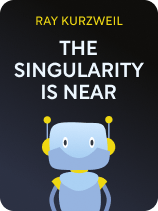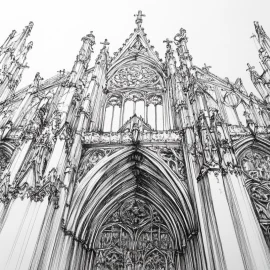

This article is an excerpt from the Shortform book guide to "The Singularity Is Near" by Ray Kurzweil. Shortform has the world's best summaries and analyses of books you should be reading.
Like this article? Sign up for a free trial here.
How fast is technology advancing? What do these changes mean for humanity?
The Singularity Is Near by Ray Kurzweil predicts a technological shift so profound that it will change everything about our lives, how society functions, and even what it means to be human. Kurzweil calls this the “technological singularity.”
Continue reading for an overview of a book that should have our attention.
Overview of The Singularity Is Near by Ray Kurzweil
In the modern world, technology evolves at a frantic pace. Though many people now take that for granted, we may not be aware of exactly how fast technological progress is accelerating. The rapid pace of change has already impacted our lives and our world on a multitude of levels, and our headlong rush into the future may have staggering implications for our personal lives as well as for our species as a whole. But, does this mean that we should throw on the brakes, or should we embrace the forthcoming changes with open arms and open minds?
The Singularity Is Near by Ray Kurzweil was published in 2005. Kurzweil paints a picture of the future in which genetics can reprogram the body, nanotechnology builds anything we want, and the power to digitally augment our brains frees our minds from the limitations of our biological hardware. According to Kurzweil, this so-called “technological singularity” will open the door to a future in which even death may be forgotten.
Kurzweil is a computer scientist and inventor who’s written books on artificial intelligence (The Age of Spiritual Machines, 1999), technologies to extend the human lifespan (Fantastic Voyage, 2004), and the pattern recognition theory of human consciousness (How to Create a Mind, 2012). Experts and leaders in the fields of computer science, manufacturing, and biology are divided on the strength of Kurzweil’s predictions about the future of technology and humanity in general. He’s been hailed as prescient by some and criticized as overly optimistic by others.
We’ll explain the technological shift that may be on the horizon. We’ll explore the three ongoing revolutions that together may overturn our current order—advancements in bioscience, nanotechnology, and artificial intelligence. We’ll then examine Kurzweil’s predictions for how these new technologies will change everything about how we live, work, and survive into the future, as well as some of the potential dangers that all this new technology will bring.
What Is the Singularity?
The premise at the heart of Kurzweil’s predictions is that not only is the rate of technological progress increasing, but the rate at which that rate is increasing is also accelerating. The result is a coming period of transition that Kurzweil and others call the Singularity—a phase in which technology changes so fast that it’s impossible to know what’s on the other side. We’ll begin by looking at where the “singularity” concept comes from, how Kurzweil came to apply it to the process of technological advancement, and his thoughts on what it might mean for human life once technological intelligence outstrips our own.
In mathematics, a singularity is the result of an equation that produces exponential numbers flying off into infinity. In astronomy, the word “singularity” refers to the center of black holes, where matter and energy are compressed to infinite density. When Kurzweil uses the term in his projections of the future, he’s referring to a point in the future when technological progress will be so great that it will appear infinite for all practical purposes. Nevertheless, Kurzweil points out that, because the Singularity will include enhancements to human intelligence, we’ll be better equipped to understand it when it comes than we are in the present moment.
Into the Future
For now, we have to use our imagination to picture a world with such dramatic rates of change. Kurzweil started doing so as he worked in the computer industry during the 1970s. While mapping the rate of technological progress so he could guess the best time to bring products to market, he saw that the path of technology’s advancement takes the shape of an exponential curve, with a flash of mind-boggling advancement due to arrive in the 2030s and ’40s.
Kurzweil says that a key feature of this rapid growth will be the use of machines to augment human intelligence. We’ve already been doing this for decades, but as we approach the Singularity, the intellectual “center” of the human race will shift from our brains to the digital world, perhaps even going so far as to upload human consciousness into the digital realm. To some, this may be frightening, but Kurzweil believes the transition will be consensual and gradual. Whatever intelligence comes “after” us will be produced by and modeled on human consciousness and thought. No matter what form our future selves take, the information that constitutes our minds, personalities, and underlying humanity will continue uninterrupted.
Exponential Progress
Kurzweil’s predictions may seem like science fiction, but he grounds them in an analysis of ongoing trends in technological advancement. These trends suggest that our capabilities as a species are increasing at an exponential rate. We’ll explain what exponential growth means in practice, how it applies to technological development, and what Kurzweil sees as exponential advancement in parts of human society beyond what’s governed by mere machines.
When we say that something’s growth is exponential, we mean that it increases by multiplication rather than by addition, as is the case with linear growth. For example, if a factory produces 20 widgets each day, then the pile of widgets it’s created grows linearly—20 on the first day, 40 on the second, 60 on the third, and so on. But consider the population of an invasive species when it moves into an area with no natural predators. Each generation may be double the size of the one that came before, growing exponentially. If you begin with 20 individuals, the second generation will include 40, the third, 80, then 160, 320, 640, 1280, and so on, until their habitat is changed beyond recognition because of the effects of their presence.
Kurzweil applies this same principle when charting the progress of technological innovations. Each advancement multiplies the power of what came before, in turn fostering and speeding up the next round of innovations.
When applied to technology, exponential trends may be hard to spot in the short term, but when you look at long-term progress, the evidence is compelling. For example, consider the advances in communication over the expanse of human history. For millennia, information could spread no faster than humans could travel via foot, horse, or boat. It’s been only 200 years since the invention of the telegraph allowed instant (if sporadic) communication across long distances. The telephone came 50 years later, phones you could dial came 50 years after that, and portable phones after another 50 years. Today, we upgrade phones every few years, increasing their collective capacity to send and receive pictures, sound, and all manner of data.
The Pattern of Change
Kurzweil explains that these advancements go in phases. As every new technology is introduced, it catches on slowly as its kinks are worked out. Following this is a burst of rapid growth as the technology is accepted and spreads throughout society. Once a technology has spread and matured, advancement within it seems to slow down, but this pause is just an illusion. Once a technology hits its “plateau,” its limitations become apparent and work begins on the next innovation that will replace it and propel the next paradigm, just as cell phones have replaced landlines. Kurzweil’s point is that these technological changes are happening faster and faster—years instead of decades, decades instead of centuries.
Kurzweil also argues that the coming tectonic shifts in society won’t be due to growth in one field of human endeavor but in every aspect of society all at once. These include accelerating economic growth, especially in the developing world, an exponential increase in the availability of education worldwide, and the rapidly multiplying power of computing available in cheaper and faster devices as measured by the amount of computation per dollar. Writing in 2005, Kurzweil predicted that all these forces would result in a dramatic decrease in global poverty coupled with personal computers running at near-human brain capacity by the 2020s. However, every field of advancement brings with it a new host of problems and concerns.
The Biotech Revolution
Kurzweil identifies three principal areas of technological advancement that he says will have the greatest impact on the world to come. The first of these is biotechnology, in which advances in medicine and genetic engineering will dramatically extend the human lifespan while at the same time improving the quality of life. Here, we’ll explore the trends in biotechnology that Kurzweil highlights as the most intriguing—the use of genetics to create designer drugs, the progress toward rewriting DNA itself, and the potential to grow your own replacement organs by repurposing other cells in your body.
The first of these trends involves our ability to chase immortality via preventative maintenance on our bodies. This is already possible to some extent through the use of exercise, diet, and supplements. Kurzweil suggests that the more we learn about DNA, the more we’re able to enhance this ability through the creation of bespoke disease-fighting medication that’s tailored to the specific genetic code of an individual. As opposed to broad-ranging chemical medications with their array of unwanted side effects, treatments tailored to a person’s genetic code can maximize the body’s defenses, combating disease and even turning back aging.
Beyond targeting medication for individuals’ genetics, Kurzweil says that our ability to affect genes themselves is accelerating. The ultimate aim of this line of progress is to inject new DNA into the nucleus of the cell. This would let us replace damaged genes with healthy ones, eliminating genetic diseases and even introducing new genetic abilities, supplanting evolution by random mutations with human-designed, beneficial DNA. Kurzweil acknowledges that the main hurdle of gene manipulation is getting the altered genetic code past the cell’s natural defenses. If this can be accomplished, we could eliminate cancers, rid the body of toxins, and put a halt to the mitochondrial mutations that drive the aging process and eventually lead to death.
The third path of research that Kurzweil writes about is in the replacement of sick and damaged organs. At present, this requires an organ donor and a risky surgical procedure. But, what if your body could be instructed to grow its own replacement parts? A potential avenue for this branches out from research into human cloning (which, in itself, Kurzweil finds ethically questionable). The breakthrough may come in a way to not only clone individual cells, but to reprogram them to serve other functions. Skin cells could be used to grow a new liver or kidney without running the risk of organ rejection, since the replacements would be from your own body and therefore already biologically compatible with the rest of your internal systems.
The Nanotech Revolution
In tandem with advances in medical science, Kurzweil discusses a new field of engineering with the potential to overturn our entire materials-based economy. Nanotechnology—molecular machines that operate on the smallest scale—can let us build products from elemental base components by putting them together atom by atom. We’ll discuss the basic premise of nanotechnology, Kurzweil’s assessment of our progress toward achieving it, and some of the ways that molecular machines could both enhance and disrupt our everyday lives.
The idea for nanotechnology rose from two separate engineering concepts—hypothetical machines that build copies of themselves, and microscopic machines that can build larger constructs by assembling their molecules and atoms. Kurzweil argues that we know these machines are possible because they already exist inside our cells as the proteins and enzymes that facilitate life. Developing artificial nanotechnology requires duplicating and improving upon systems that nature took billions of years to evolve, perhaps with carbon-based diamond components more durable than biological micromachines.
The Rise of the Robots
Kurzweil envisions a tabletop device that can produce trillions of nanoscale robots (nanobots) on demand. These nanobots could use basic chemical ingredients to construct anything you own a software design of, be it a toothbrush, a t-shirt, or a turkey sandwich. The only cost of production would be the cost of raw ingredients—perhaps including garbage for your bots to recycle—plus the cost of the software design for whatever it is you want to build. Nanobots would also have medical uses, such as targeting and destroying pathogens more efficiently than your white blood cells or repairing damaged tissue faster than you could naturally heal.
Nanobots could eliminate scarcity while also upending the entire manufacturing and shipping industries. Kurzweil argues that, in such an economy, information will be the most important resource since the most vital commodity will be designs for nanobots to follow.
Kurzweil points out that we’ve been on the road toward nanotechnology for some time. The size of circuit components has been shrinking for 100 years and is now crossing into the nanoscale range, creating ever faster and more efficient computers. Kurzweil believes nanobots will become viable in the 2020s, and once we apply nanotech to manufacturing, the ongoing increase in computing power will spill into our ability to create things on demand. Nanobots may also be able to clean up the garbage and pollution we’ve created, reusing it to build the society of the future. With trillions of nanobots at our command, we’ll be able to reshape the world as we see fit, with all the benefits and hazards that entails.
The AI Revolution
The third and potentially most transformative development, toward which we are already well underway, will be when we create strong artificial intelligence. “Strong AI” refers to the state in which computers will reproduce and exceed every aspect of human intelligence, including the attainment of conscious thought. Kurzweil describes the steps we’ve already taken to digitally replicate human thought, the ways in which machine intelligence is objectively better than human intelligence, and the scenario he envisions for how human-level AI will be developed.
At present, we already depend on narrow AI for many thought-based tasks that humans used to perform, such as designing buildings, making market predictions, and searching for data through millions of archived documents. These powerful, though limited, AI programs come in a variety of models—expert systems based on human logic and experience, probability calculators that make predictions based on past occurrences, and neural networks that simulate the learning process of the human brain itself. With each of these systems, Kurzweil says we’ve learned that machines’ ability to mimic human skills goes from poor to superior in a short amount of time. Computers are very fast learners.
Speed isn’t the only avenue in which machine intelligence can easily outpace us. Computers share information more easily than humans, they can link together to increase computing power, and their information recall is far more accurate than human memory. But how will we know when strong AI has been achieved? Kurzweil sets the bar at the level when computers can truly understand human language, instead of merely mimicking understanding. By analyzing advancements in computational power, memory storage, pattern recognition, and neural simulations, Kurzweil predicts the coming of human-level strong AI around the year 2029.
The danger inherent in creating strong AI is that a machine consciousness exceeding our own will be practically impossible to control. This has led some futurists to speculate that the first strong AI will immediately create even more powerful AIs than itself, but Kurzweil disagrees. Instead, he believes that there will be a “ramping up” stage during which the AI expands its knowledge base. After that, instead of replacing humans, AI will become a tool to expand human thought as we learn to directly augment our brains with machine intelligence.
Building a Better Brain
Kurzweil argues that the path to strong AI requires learning how the human brain works and duplicating its cognitive functions electronically. Our accelerating progress in computing power makes reproducing brain functions easier every year—a digital brain is not only possible, but it may be inevitable. We’ll discuss advances in brain research, how they apply to computation models, and how, if computers can simulate brains, you may one day be able to upload your whole mind into the digital world.
Historically, the medical tools we’ve used to analyze and understand the brain were crude, but like all other modern technology, they’re improving at an accelerated pace. It’s now possible to image a functioning brain down to the level of individual neurons. Kurzweil says computer models of the brain are likewise improving at a phenomenal rate. While the brain is extremely complex with trillions of neural connections, there is a lot of built-in redundancy. An effective computer model of a brain doesn’t have to simulate every neuron firing, and we’ve already made remarkable progress modeling some of the brain’s specific regions.
Kurzweil admits that the brain’s major advantage over digital computers is that it is massively parallel—it sets countless neural pathways to solving any problem all at the same time, as opposed to the more linear approach taken by traditional computing. This more than makes up for neurons’ relatively slow chemical transmission of data. However, the hardware for fast parallel processing is rapidly becoming available for digital computers. Another advantage of the human brain is that via neuroplasticity, it can rearrange its connections and adapt, something that physical computers cannot do. Nevertheless, Kurzweil insists that the brain’s ability to adapt and reorder itself can be addressed in the realm of software if not hardware.
Mapping the Brain
One thing to remember is that the brain isn’t perfect—it evolved to function just well enough for our primitive ancestors to survive. Once we can digitally replicate the brain, we’ll also be able to improve its design, and once our computing power is great enough, Kurzweil believes that it will become possible to scan and upload the memories and specific neural connections of a person’s mind into a digital self. Though this may sound like pure science fiction, the level of computing necessary should be readily available in the 2030s, so creating a digital backup of yourself will only be a question of software and the state of brain-scanning technology.
Whether or not your digital self is still “you” will pose both philosophical and legal conundrums. Our entire legal system revolves around the rights of living, conscious beings, so the matter of whether a digital being can be conscious will become much more than a hypothetical issue. However, Kurzweil suggests that as we work through the legal ramifications, our transition from biological to digital entities won’t be abrupt. Instead, it will be a slow process as we gradually augment our physical brains with more and more digital capabilities, until the center of our consciousness gradually slides from the physical world into the electronic realm.
Upgrading Humanity
Despite its profound impact, the AI revolution will be only one of the drivers of the next stage in human evolution. Advances in genetics, nanotechnology, and computing power will all intertwine to create a future that we can only guess at from our current vantage point. Kurzweil describes how nanotechnology and medical science will combine to create stronger and more durable human bodies, while biotechnology and computer science will expand the reach of our minds. Beyond that, nanotech and strong AI will allow our future digital selves to manifest in the world in whatever form we choose.
Kurzweil writes that the first step of this process will be the creation of improved human bodies by merging nanotech with biology. At present, we already modify ourselves using medications, nutritional supplements, and prosthetic devices. By introducing nanobots into our bodies, we can use them to efficiently target pathogens and cancers, deliver oxygen and nutrients to our cells, and build organs on demand.
People may balk at having micromachines swarming through their bodies, but as with any new technology, there will be a wave of early adopters until the benefits become clear. Kurzweil predicts widespread acceptance of nanotech-enhanced bodies at some point in the 2030s.
As for the brain, progress is being made to incorporate circuitry into the nervous system, primarily for use in treating spinal cord injuries, damaged nerves, and other neurological diseases. Kurzweil states that the next logical step is using brain-computer interfaces to improve the functionality of healthy nervous systems. Imagine being able to operate electronics with a thought, to search the web directly from your mind, or to experience virtual reality without wearing a clunky headset. With the oncoming advent of strong AI, being able to interface directly with computers becomes increasingly important. After all, we’d rather have AI become part of our human intelligence instead of replacing it completely.
The Information Age
Remodeling our bodies and expanding our minds are the two vital steps to bridging the gap between our present biological forms and our post-Singularity digital selves. In a future in which microscopic nanobots can construct anything our AI-augmented minds design, information will be central to every aspect of our lives. Kurzweil explains why this will be so while speculating about how far an information-based society can go as it spreads its computational abilities beyond the confines of one lonely planet.
Kurzweil argues that, once our minds have gone digital, our physical forms won’t be so important. Rather, what will be vital in the future is maintaining the integrity of our information. Our digital selves will be made of information, which we’ll be able to embody in both the virtual world and the real one, perhaps by using nanobots to construct new physical bodies as we wish. Instead of being confined to one form, we’ll be able to project our digital selves into any environment we imagine. Of course, a society in which this is possible will look nothing like the one we live in today.
Economically, we’ve already shifted to prioritizing intellectual property over the creation of material goods. In a future where nanobots manufacture products as an afterthought of design, generating new information will be the basis of all human endeavor. With the power of AI enhancing human creativity, there’s no way to predict the wonders we’ll achieve. Kurzweil writes that, in such a world, education will be even more important than it is today. At the same time, he believes that the “digital divide” between rich and poor will all but disappear once AI-tailored classes designed for individual learning become easily available all across the globe.
As technology accelerates into the Singularity and beyond, scenarios beyond our current human experience enter the realm of possibility. Kurzweil suggests that as nanomachines permeate everything we build, so does their computational power, in effect turning everything into a computer. The result is a future in which even more of the physical world becomes imbued with machine intelligence. In a sense, the world will come alive—and not just ours. If we spread our technology and digital selves to other planets in our solar system and beyond, then every world we can reach with our spacecraft will be brimming with intelligent, artificial life.
Possible Pitfalls
The road to the future of the Singularity isn’t without its dangers. Every technology has the potential for misuse, and the hazards involved with biotech, nanotech, and AI are substantial. Kurzweil details some of those dangers while arguing the futility of trying to halt technological progress. Instead, he suggests that the only solution is for responsible people to take an active role in guiding technological regulation and development.
If there’s one lesson to be learned from the 20th century, it’s that technology has the potential to wipe out the human race if mishandled. While the chief threat for most of those years was that of global nuclear annihilation, biotechnology now makes it possible to engineer a virus more contagious or deadly than any in nature. Nevertheless, Kurzweil points out that the threat of artificial pathogens hasn’t slowed down genetic research. Instead, the medical benefits of harnessing the genetic code have only sped up research into new biotechnology applications.
Nanotech presents an even greater hazard—that swarms of self-replicating, microscopic robots might run amok, disassembling everything in their path, including buildings, animals, plants, and even us. The ultimate nightmare nanotech scenario is that unstoppable nanobots, either by accident or malicious design, spread across the world and reduce every piece of matter into a sea of undifferentiated ooze. Though the technology to create such a plague hasn’t yet been invented, Kurzweil reports that concerned scientists are already discussing what safeguards will have to be developed as research into nanotechnology continues.
Navigating the Perils
Some people suggest that the best safeguard possible is to ban any further research into hazardous technology, but Kurzweil argues that that’s a non-starter. A complete cessation of scientific research would have to be enforced by a global dictatorship, and since no such dictatorship exists, research will always continue somewhere. He believes that the only defense against the dangers of technology is for governments, corporations, and the scientific community to cooperate in developing responsible regulations and viable defenses that allow for research to progress while putting an infrastructure in place to combat potential hazards.
The most difficult hazard to address is the one presented by artificial intelligence, in particular a strong AI that doesn’t share humanity’s ethics or values. Kurzweil reiterates that against strong AI, there may be no defense because it will be by definition more intelligent and capable than we are. Even if it’s used to augment us, not replace us, AI will likely empower humanity’s worst instincts as well as its good ones. The one solution that Kurzweil offers is to ensure that any future AI learns and grows out of the best we have to offer. Artificial intelligence will be humanity’s offspring, and like any good parents, we should guide its growth by presenting the best version of ourselves that we can.

———End of Preview———
Like what you just read? Read the rest of the world's best book summary and analysis of Ray Kurzweil's "The Singularity Is Near" at Shortform.
Here's what you'll find in our full The Singularity Is Near summary:
- The upcoming technological shift that will change everything
- The revolutions in bioscience, nanotechnology, and artificial intelligence
- How Kurzweil's predictions held up over time






